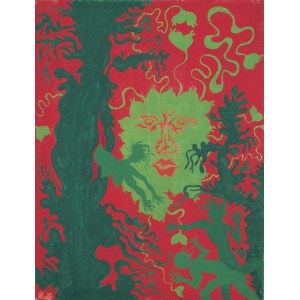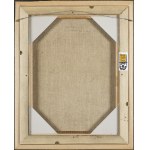64.0 x 49.5 cm - oil, canvas signed on the reverse: Jan Dobkowski | "Trees also give birth", 1969
below a small sketch
Painting exhibited and described:
- Neo-neo-neo. Jan Dobkowski (Dobson), Jerzy Ryszard Zieliński (Jurry), National Museum in Warsaw, "Zachęta" Gallery of Contemporary Art, 14 XI 1994 - 8 I 1995, cat. no. 101, p. 88.
Joyful and pulsating with vital contrast, Trees Also Give Birth was created during the activity of the duo NEO -NEO-NEO (1967-1970). It was founded by two students of Jan Cybis who rebelled against academic teaching in a post-impressionist style - Jan Dobkowski and Jerzy Ryszard Zieliński. Their innovative, synthetic painting proposal - flatly laid and cleanly juxtaposed color patches edged with soft contours - had all the characteristics of an artistic manifesto. The appearance of the artists on the scene of Polish art in the 1960s was commented on by Anda Rottenberg: The loudest debut was made by the Neo-Neo-Neo duo, namely 'Jurry' (Jerzy Zielinski) and 'Dobson' (Jan Dobkowski). Their first exhibition at the Contemporary gallery consisted of red and green canvases filled with flat shapes (often with erotic connotations) drawn with decorative, 'Art Nouveau' lines. These cheerful, somewhat psychedelic paintings, in tune with the hippie subculture that was widespread at the time, were the only Polish version of pop art, if one does not take into account its folk version proposed by Hasior. (quoted in A. Rottenberg, Art in Poland 1945-2005, Warsaw 2005, p. 189).
Despite their common pop-art pedigree, from the early days of the group's establishment, the interests of "Dobson" - to a greater extent than "Yurry's" - were centered around nature in the broadest sense. With the help of precise, flowing lines he drew organic shapes expressing his admiration for all forms of life, sexuality, the uncontaminated industrial biosphere. The artist explained the genesis of the works of this period this way: I was mainly concerned with showing the pannatura, the space of human psychology, his intimate feelings and so on. And this came from the fact that I was close to the philosophy of hippies, as if I were a hippie. I believed that I could share everything. I believed that I had to depict love, paint love and nature, against politics, against all arrangements (quoted in Conversation on NEO-NEO-NEO [in:] NEO-NEO-NEO. Jan Dobkowski (Dobson), Jerzy Ryszard Zieliński (Jurry), National Museum in Warsaw, Zachęta Contemporary Art Gallery, p. 12).
A visual summary of the artist's hippie "confession of faith" in love and the forces of nature is the red-green composition presented in the catalog, which depicts interpenetrating, multiplied biological forms. Bubbling with life, the horror vacui of limp structures, from which trees and human silhouettes emerge, is a sensual praise of the unity of man and nature. The experience of the NEO-NEO-NEO period - highly regarded in the painter's oeuvre - paved the way for his subsequent creative explorations. Years later, in a conversation with Elżbieta Dzikowska, he stated: This was the beginning of my self, my self-definition.
♣ to the auctioned price, in addition to other costs, will be added a fee resulting from the right of the creator and his heirs to receive remuneration in accordance with the Act of February 4, 1994 - on Copyright and Related Rights (droit de suite)
Jan Dobkowski (Łomża 1942, lives in Warsaw) studied from 1962-1968 at the Faculty of Painting of the Warsaw Academy of Fine Arts under Prof. Juliusz Studnicki and Jan Cybis. While still a student, in 1966, he formed an artistic duo, with Jerzy (Jurry) Zieliński as his partner. Their first joint exhibition, entitled Neo-Neo-Neo, took place in Warsaw in 1967, and they exhibited together until 1970. 1968 saw Dobkowski's first green and red paintings (using the pseudonym Dobson at the time). In these works, operating with supple, wavy lines, in which the influence of Art Nouveau was seen, the artist used methods derived from op-art in order to produce optical illusions (swirling, blurring, apparent movement of forms). In parallel with his paintings, he also created plate and foil forms for mounting in space. A gold medal at the Golden Grape Symposium in Zielona Gora in 1971 and a nearly year-long stay in the US on a Kosciuszko Foundation scholarship in 1972 were the next stages of the painter's successful career. A marked change in the mood and meaning of his works came with the events of 1980-1981, especially the introduction of martial law. At that time he marked monochromatic, dark canvases with faint, flaccid lines of drawing. The most common motifs were patriotic and religious symbols, spiced up with titles alluding to the realities of the time. Another radical change occurred around 1990. The symbolic harbinger of the new period became a huge, joyful painting exploding with a wealth of colors, shapes and movement ...and life is flowing.... (394 x 588 cm) from 1990-1991. Similar formal features characterize the artist's work throughout the decade of the 1990s. In parallel with painting, Dobkowski works on drawing, which is a very important complement to his work.
Recently viewed
Please log in to see lots list
Favourites
Please log in to see lots list













